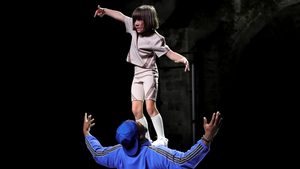Review: The Festival d'Avignon Presents SILENT LEGACY By Maud Le Pladec and Jr Maddripp
Silent Legacy is a diptych of appropriation.

Silent Legacy, now in performance at the Festival d'Avignon's Cloître des Cèlestins, asks questions about points of exchange. The relationship between the dancer and choreographer is complex. Literarily focused theatre's collaborative quality sometimes benefits from the boundaries made by script writing. In this way, the playwright has a product outside the performance. In most instances with dance, the work can only exist within the body of the performer. Silent Legacy presents its audience with two such points of exchange.
Eight-year-old Québécois krump prodigy Adeline Kerry Cruz enters the stage. A stark white box of light frames her. She performs with ferocity. Her chest pumps and her arms reach out, as if to say, "you want some of this?" The dramatic square lighting follows her around the stage. It then expands. The rhythmic music by Chloé Thévenin pulses through the space. She directs her attention to an audience member. It is her mentor, Jr Maddripp.
The eight-year-old taunts him. He stands. Dressed in a purple tracksuit, he looms over her. She stares him down. He shows us, with photorealistic dance effects, where Kerry Cruz is heading as an artist. Where her chest pumps are intense and singular, his are varied and controlled. She puts on a jacket covered in multicolored fringe, designed by Christelle Kocher. Wearing this, she moves under strobe lights designed by Éric Soyer.
At the end of their interaction she stands on his shoulders, arms outstretched. He is a thirty-year-old black man; she is an eight-year-old white girl. Questions that lingered in the mind for the first portion of the piece regarding cultural appropriation are quieted in this act of support. He seems justifiably proud of her. The words "Silent Legacy" appear on the cloister wall.
Audrey Merlius performs the piece's second portion. Merilus's movements are exacting and unaffected. The choreography in this portion is more academic-modern than street. She strides through the upper archways of the cloister. Once dormant white florescent lights pop into life. Sound designer Vincent le Meur picks up her voice and has it echo in the music's soundscape. These sounds are mostly tennis match style grunts. However, in one moment she takes a brief break on stage, collecting herself. She then unleashes a cry that is molded to the pulse of the music beneath her. Merlius is a black woman; Choreographer Maud Le Pladec is a white woman.
Silent Legacy is a diptych of appropriation. This term, though loaded, is in itself a neutral quality of artistic interaction. Appropriation is going to come from collaboration, especially when there is a choreographer-dancer or mentor-mentee dynamic. It's the frame of marginalization that charges this quality. Who do we get to see ourselves in? Who do we get to gift and burden with our legacy? Silent Legacy offers us two possible test cases.
Photo Credit: ANGE ESPOSITO
Reader Reviews
Videos

